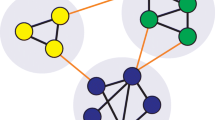Abstract
The discovery of community structure in a large number of complex networks has attracted lots of interest in recent years. One category of algorithms for detecting community structure, the divisive algorithms, has been proposed and improved impressively. In this paper, we propose an improved divisive algorithm, the basic idea of which is to take more than one parameters into consideration to describe the networks from different points of view. Although its basic idea appears to be a little simple, it is shown experimentally that it outperforms some other algorithms when it is applied to the networks with a relatively obscure community structure. We also demonstrate its effectiveness by applying it to IPv6 backbone network. The communities detected by our algorithm indicate that although underdeveloped compared with IPv4 network, IPv6 network has already exhibited a preliminary community structure. Moreover, our algorithm can be further extended and adapted in the future. In fact, it suggests a simple yet possibly efficient way to improve algorithms.
Similar content being viewed by others
Explore related subjects
Discover the latest articles and news from researchers in related subjects, suggested using machine learning.References
Girvan M, Newman M E J. Community structure in social and biological networks. Proceedings of National Academy of Sciences of the United States of America, 2002, 99(12): 7821–7826
Newman M E J, Girvan M. Finding and evaluating community structure in networks. Physical Review E, 2004, 69, 026113
Tyler J, Wilkinson D, Huberman B. Email as spectroscopy: auto discovery of community structure within organizations. In: Proceedings of International Conference on Communities and Technologies. Amsterdam, 2003, 81–96
Radicchi F, Castellano C, Cecconi F, Loreto V, Parisi D. Defining and identifying communities in networks. Proceedings of National Academy of Sciences of the United States of America, 2004, 101(9): 2658–2663
Fortunato S, Latora V, Marchiori M. A method to find community structures based on information centrality. Physical Review E, 2004, 70, 056104
Duch J, Arenas A. Community detection in complex networks using extreme optimization. Physical Review E, 2005, 72, 027104
Newman M E J. From the cover: modularity and community structure in networks. Proceedings of National Academy of Sciences of the United States of America, 2006, 103(23): 8577–8582
Zachary W W. An information flow model for conflict and fission in small groups. Journal of Anthropological Research, 1997, 33(4): 452–473
CAIDA. Visualizing IPv6 AS-level internet topology. http://www.caida.org
http://www.caida.org/analysis/topology/as_core_network/ipv6.xml
Author information
Authors and Affiliations
Corresponding author
Rights and permissions
About this article
Cite this article
Guo, Y., Xu, K. An improved algorithm for finding community structure in networks with an application to IPv6 backbone network. Front. Comput. Sc. China 1, 459–467 (2007). https://doi.org/10.1007/s11704-007-0045-9
Received:
Accepted:
Issue Date:
DOI: https://doi.org/10.1007/s11704-007-0045-9




